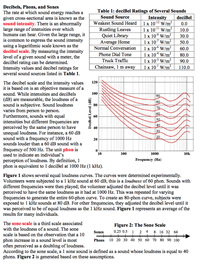 Sound Loudness and the Sone Scale
Sound Loudness and the Sone Scale
Resource:
The Science Reasoning Center: Sound Loudness and the Sone Scale
Grade Level: High School
Description:
This passage describes the relationship between sound intensity and the decibel level, between the perceived loudness of a sound and its frequency and decibel level, and the sone scale of loudness. Information is presented in the form of a table, a graph with several equal loudness curves and a figure representing the sone scale. Questions target a student's ability to identify and use the relationship between intensity and the decibel rating, to read values from and to interpret a complex graph, to use data from two or more data presentations in order to compare two sounds, and to combine information from two or more data presentations in order to draw valid conclusions.
This activity aligns with the three dimensions of the Next Generation Science Standards in the manner described below:
| Definitions of Energy (HS-PS3.A.2): At the macroscopic scale, energy manifests itself in multiple ways, such as in motion, sound, light, and thermal energy. |
The rate at which sound energy reaches a given cross-sectional area is known as sound intensity. There is an abnormally large range of intensities over which humans can hear. Given the large range, it is common to express the sound intensity using a logarithmic scale known as the decibel scale. While intensities and decibels are measurable with a scientific instrument, the loudness of a sound is subjective and varies from person to person. As such, this passage also explores human perception of a sound’s loudness for a range of frequencies. |
| Scale, Proportion, and Quantity: The significance of a phenomenon is dependent on the scale, proportion, and quantity at which it occurs. |
Given the large range of intensities over which a human can hear, it is common to express sound intensity using a logarithmic scale known as the decibel system. While intensities and decibels can be objectively measured with a scientific instrument, the loudness of a sound is subjective and varies from person to person. In light of this, two additional scales (the phon and sone scales) are explored as measures of the perceived loudness of sound. |
| Analyzing and Interpreting Data: Analyze data using computational models in order to make valid and reliable scientific claims. |
Many of the questions at the close of this passage ask students to analyze and synthesize data from the multiple data presentations included. Information is presented in the form of a table, a graph with several equal loudness curves, and a figure representing the sone scale. Questions target a student's ability to identify and use the relationship between intensity and the decibel rating, to read values from and to interpret a complex graph, to use data from two or more data presentations in order to compare two sounds, and to combine information from two or more data presentations in order to draw valid conclusions. |
| Using Mathematical and Computational Thinking: Use mathematical representations of phenomena to describe explanations. |
Converting between the sound intensity scale and the decibel scales, or between the phon scale and sone scales, provides students with an opportunity to perform non-linear conversions. Such computational reasoning is important in each of the science disciplines. Similar logarithmic relationships can be found in chemistry (pH scale), in biology (population studies), and in earth/space science (Richter scale). |
| Obtaining, Evaluating, and Communicating Information: Critically read scientific literature adapted for classroom use to determine central ideas and obtain scientific/technical information. |
This passage is comprised of technical information in the form of what may be new vocabulary, quantities, and data presentations. While students will need to determine the central ideas of the passage, they must also obtain and evaluate particular information in addressing the end-of-passage questions. Both the skills of seeing the ‘big picture’ as well as finding specific details within scientific text are important for students as they develop the ability to obtain, evaluate, and communicate technical information. |
Associated Reading from The Physics Classroom
Other Supporting Pages at The Physics Classroom:
View Infographic.
(Coming Soon)
Search the NGSS Corner
Maybe you're looking for something really specific that pertains to a desired topic and emphasizes one or more of the listed NGSS dimensions. Why not try a search of this section of our website? Simply select from one or more of the pull-down menus and click Search This page will reload and a collection of possibilities will be displayed in this section of the page and sorted by relevancy.